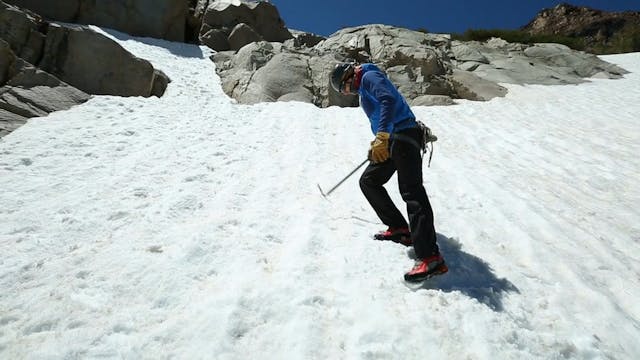Alpine: 3. Kicking Steps - Duck Foot, Flat Foot & Front Pointing
Alpine & Mountaineering
•
2m 0s
In this video we show how to kick steps in the snow. When snow conditions are soft enough to allow your boots to penetrate the surface, kicking steps tends to be the most efficient and secure way to climb steep snow.
When kicking steps you will either have ski poles or an ice axe in one hand, typically used as a cane. For more on this, see our video on “Ice Axe Positioning”[hyperlink to video] for proper techniques.
The way to kick steps in the snow were first described by French alpinists, and the terms still have French names:
Flat Foot - “Pied a plat” translates to “flat foot”, which describes walking on flat or low-angle snow. Keep your heels low, and kick a flat platform in the snow.
Duck Foot - As the angle steepens, and you start to climb straight up the fall line, you might choose to use “Pied en canard”, or the “duck foot”. With duck feet, your toes point outward so you can try to put some weight on your heels instead of just on your toes. This is very similar to the herringbone technique that skiers sometimes use to ascend a short uphill section.
Front-pointing - If the snow is very steep, you will probably gravitate to “front pointing.” Front pointing is an often-used foot technique for steep snow and ice climbing.
In soft snow this will be done with the front of your boot, but in firm snow or ice this will be with crampon front points. In deep snow, the resulting foothold looks like a mailbox or letter box...this technique is described by the French as “Boîte aux lettres”.
Front pointing can be tiring on the calf muscles, but can also be a fast and efficient method of travel. With front pointing, remember to use the weight of your boot to initiate the swing (or kick), and to pivot at the knee joint.
Drop the heel to minimize calf fatigue and, as much as possible, try to avoid calf cramps by varying front pointing with steps and techniques introduced in other CTT videos.
We hope you found this video helpful. Feel free to comment below with questions or thoughts!
Please remember, climbing is inherently dangerous. Climb at your own risk.
Up Next in Alpine & Mountaineering
-
Alpine: 4. Snow Travel - Chopping Steps
In this video we look at how to chop steps for climbing snow.
There are times in the mountains when most of the terrain will be on rock, trails, and talus. This is typically late summer or in the autumn, or lower elevation alpine areas following a lean winter. Sometimes you may choose to leave...
-
Alpine: 5. Snow Travel - Duck Foot
In this video we look at the duck foot technique for climbing snow.
When ascending up a snow slope of moderate angle, the most efficient method may be the duck foot method. The French term for this is “pied en canard”. It is similar to the herringbone technique that a skier would do to ascend...
-
Alpine: 6. Snow Travel Considerations
Snow is an incredible medium on which to travel, and often provides efficient travel conditions. In this video, we look at various aspects of climbing on snow.
Perfect spring “corn” snow that is well consolidated and soft enough to take a boot kick or ski edge, or firmer snow that takes crampo...


